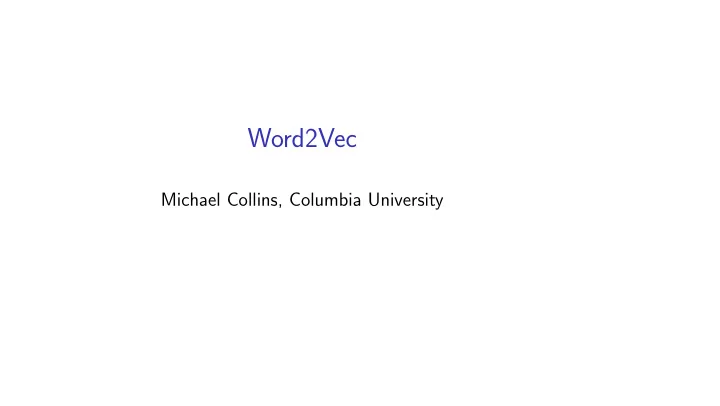

Word2Vec Michael Collins, Columbia University
Motivation ◮ We can easily collect very large amounts of unlabeled text data ◮ Can we learn useful representations (e.g., word embeddings) from unlabeled data?
Bigrams from Unlabeled Data ◮ Given a corpus, extract a training set { x ( i ) , y ( i ) } for i = 1 . . . n , where each x ( i ) ∈ V , y ( i ) ∈ V , where V is the vocabulary ◮ For example, Hispaniola quickly became an important base from which Spain expanded its empire into the rest of the Western Hemisphere . Given a window size of + / − 3 , for x = base we get the pairs ( base , became ) , ( base , an ) , ( base , important ) , ( base , from ) , ( base , which ) , ( base , Spain )
Learning Word Embeddings ◮ Given a corpus, extract a training set { x ( i ) , y ( i ) } for i = 1 . . . n , where each x ( i ) ∈ V , y ( i ) ∈ V , where V is the vocabulary ◮ For each word w ∈ V , define word embeddings θ ′ ( w ) ∈ R d and θ ( w ) ∈ R d ◮ Define Θ ′ , Θ to be the two matrices of embeddings parameters ◮ Can then define p ( y ( i ) | x ( i ) ; Θ , Θ ′ ) = exp { θ ′ ( x ( i ) ) · θ ( y ( i ) ) } Z ( x ( i ) ; Θ , Θ ′ ) where Z ( x ( i ) ; Θ , Θ ′ ) = � y ∈V exp { θ ′ ( x ( i ) ) · θ ( y ) }
Learning Word Embeddings (Continued) ◮ Can define p ( y ( i ) | x ( i ) ; Θ , Θ ′ ) = exp { θ ′ ( x ( i ) ) · θ ( y ( i ) ) } Z ( x ( i ) ; Θ , Θ ′ ) where Z ( x ( i ) ; Θ , Θ ′ ) = � y ∈V exp { θ ′ ( x ( i ) ) · θ ( y ) } ◮ A first objective function that can be maximized using stochastic gradient: n � log p ( y ( i ) | x ( i ) ; Θ , Θ ′ ) L (Θ , Θ ′ ) = i =1 n � � θ ′ ( x ( i ) ) · θ ( y ( i ) ) } − log exp { θ ′ ( x ( i ) ) · θ ( y ) } = i =1 y ∈V � �� � Expensive!
An Alternative: Negative Sampling ◮ Given a corpus, extract a training set { x ( i ) , y ( i ) } for i = 1 . . . n , where each x ( i ) ∈ V , y ( i ) ∈ V , where V is the vocabulary ◮ In addition, for each i sample y ( i,k ) for k = 1 . . . K from a “noise” distribution p n ( y ) . E.g., p n ( y ) is the unigram distribution over words y ◮ A new loss function: n exp { θ ′ ( x ( i ) ) · θ ( y ( i ) ) } � L (Θ ′ , Θ) = log 1 + exp { θ ′ ( x ( i ) ) · θ ( y ( i ) ) } i =1 n K 1 � � + log 1 + exp { θ ′ ( x ( i ) ) · θ ( y ( i,k ) ) } i =1 k =1
Recommend
More recommend